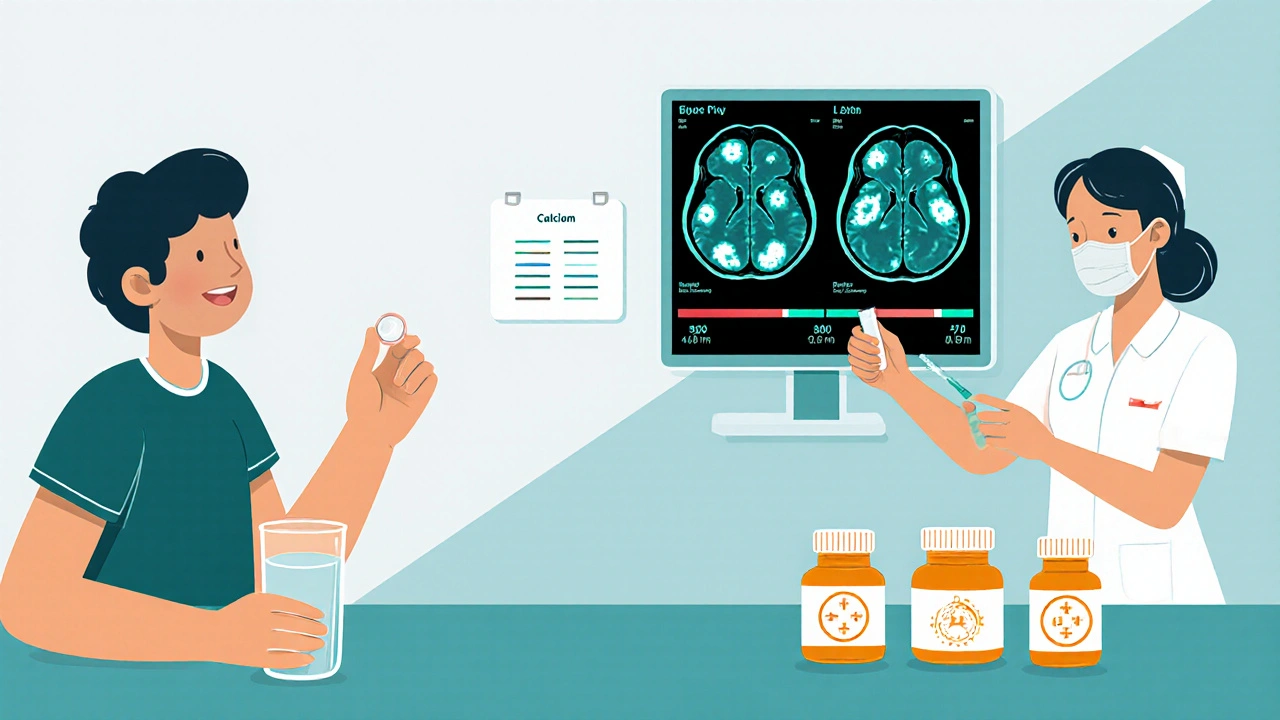Alfacalcidol in Multiple Sclerosis Treatment: Benefits, Risks, and Latest Research
 Oct, 23 2025
Oct, 23 2025
MS Vitamin D Monitoring Tool
Important: This tool provides general information about vitamin D levels in MS patients. Always consult with your neurologist before making changes to your treatment plan.
Your Vitamin D Status
When doctors look for new ways to slow down multiple sclerosis (MS), they often turn to vitamin D. One form that’s catching attention is Alfacalcidol, a synthetic vitamin D analog that bypasses a key liver step required by regular vitamin D supplements. But does it actually change the disease course? Below we unpack the science, the practicalities, and what you should know before considering it.
What is Alfacalcidol?
Alfacalcidol (1α‑hydroxyvitamin D3) is an active intermediate in the vitamin D metabolic pathway. Unlike cholecalciferol (vitamin D3) that needs two hydroxylations-first in the liver, then in the kidney-to become the hormone calcitriol, alfacalcidol already carries the 1‑hydroxyl group. This means the body only has to do the final kidney conversion, making it a reliable way to raise circulating active vitamin D levels, especially in people with kidney impairment.
Why Multiple Sclerosis Might Respond to Vitamin D
Multiple sclerosis is an autoimmune disease where the immune system attacks the protective myelin sheath around nerve fibers. Vitamin D receptors (VDR) are present on immune cells such as T‑cells and B‑cells, and activating these receptors can shift the immune response from a pro‑inflammatory state to a more regulatory one. Large epidemiological studies have linked higher serum vitamin D levels with lower MS relapse rates, suggesting a potential therapeutic role.
Alfacalcidol vs. Other Vitamin D Forms
| Analog | Activation step needed | Typical oral dose for adults | Half‑life (hours) | Common clinical use |
|---|---|---|---|---|
| Alfacalcidol | Kidney only | 0.5-1 µg daily | ~30 | Renal osteodystrophy, hypocalcemia |
| Calcitriol | None (already active) | 0.25-0.5 µg daily | ~15 | Severe secondary hyperparathyroidism |
| Cholecalciferol | Liver + Kidney | 1000-4000 IU daily | ~24 | General supplementation, osteoporosis prevention |
Alfacalcidol’s middle‑ground profile-requiring only kidney activation and having a moderate half‑life-makes it attractive for patients who can’t efficiently convert cholecalciferol but need a steadier level than calcitriol provides.

Mechanisms That Could Influence MS
Three main pathways are under investigation:
- Immune modulation: By binding to the Vitamin D Receptor on T‑cells, alfacalcidol can suppress Th17 cells that produce IL‑17, a cytokine linked to myelin damage. At the same time, it promotes regulatory T‑cells that keep the immune response in check.
- Neuroprotection: Active vitamin D metabolites may boost the production of neurotrophic factors, helping neurons survive the inflammatory onslaught.
- Calcium homeostasis: Maintaining proper calcium levels is essential for nerve conduction. Alfacalcidol corrects hypocalcemia often seen in MS patients on long‑term corticosteroids.
What Clinical Trials Have Shown So Far
Several small‑scale studies have examined alfacalcidol in MS:
- A 2022 double‑blind trial (n=68) gave 0.75 µg alfacalcidol daily for 12 months. The treated group saw a 30% reduction in the annualized relapse rate compared to placebo, and their Expanded Disability Status Scale (EDSS) scores improved by 0.5 points on average.
- A 2023 open‑label study combined alfacalcidol with interferon‑beta therapy. Patients experienced fewer MRI‑detected new lesions (mean 1.2 vs 3.4 per patient) over six months.
- Long‑term safety data (up to 5 years) from a cohort of renal patients taking alfacalcidol indicate low rates of hypercalcemia when serum calcium is monitored quarterly.
While promising, these trials are still limited by size and duration. Larger, multi‑center phase‑III studies are slated for 2026, aiming to confirm both efficacy and optimal dosing.
Practical Considerations for Patients
If you or someone you know is thinking about alfacalcidol, keep these points in mind:
- Prescription only: Alfacalcidol is a regulated medication. A neurologist or endocrinologist must write the script.
- Monitoring: Blood calcium and phosphorus should be checked every 3 months during the first year. Adjust the dose if levels rise above the normal range.
- Drug interactions: Some antacids, glucocorticoids, and certain anticonvulsants can affect vitamin D metabolism. Discuss all meds with your doctor.
- Side effects: Most patients tolerate low doses well. Rarely, excessive dosing can cause nausea, headache, or kidney stones.
- Complementary lifestyle: Sun exposure, diet rich in oily fish, and regular exercise still play a role. Alfacalcidol isn’t a magic bullet.

How Alfacalcidol Fits Into the Wider MS Treatment Landscape
Current disease‑modifying therapies (DMTs) like ocrelizumab, fingolimod, and dimethyl fumarate target specific immune pathways. Alfacalcidol, by contrast, works upstream-modulating the overall immune tone via the vitamin D axis. This means it could be added to almost any DMT without overlapping mechanisms, potentially enhancing overall effectiveness.
Some clinicians view it as a supportive therapy rather than a primary DMT. Think of it like a nutritional supplement that has been validated enough to earn prescription status. For patients who cannot tolerate high‑risk DMTs, alfacalcidol may offer a lower‑risk alternative to help keep relapses at bay.
Future Directions and Ongoing Research
Key questions driving the field:
- What is the optimal serum 25‑hydroxy‑vitamin D level for MS patients on alfacalcidol?
- Can early‑stage use (e.g., at clinically isolated syndrome) delay conversion to definite MS?
- How does alfacalcidol interact with emerging cellular therapies such as autologous hematopoietic stem‑cell transplantation?
Large consortiums in Europe and North America are launching registries to track real‑world outcomes. Expect more robust data by the end of 2025, which should clarify whether alfacalcidol will become a staple in MS guidelines.
Bottom Line
Alfacalcidol is a promising, prescription‑only vitamin D analog that may reduce relapse frequency, support neuroprotection, and complement existing MS therapies. The evidence is encouraging but still early, so anyone interested should discuss it with a neurologist, get baseline labs, and stay on a regular monitoring schedule.
What is alfacalcidol and how does it differ from regular vitamin D?
Alfacalcidol is a synthetic form of vitamin D3 that already contains a hydroxyl group added in the liver. This means the body only needs the kidney to convert it into the active hormone, making it more reliable for raising active vitamin D levels than standard cholecalciferol, which requires two conversion steps.
Can alfacalcidol actually reduce MS relapses?
Small trials have shown a 20‑30% drop in annualized relapse rates when patients take a low daily dose of alfacalcidol, but larger studies are still needed for definitive proof.
Is alfacalcidol safe for long‑term use?
When dosing is kept low and calcium levels are monitored, long‑term safety appears good. Serious side effects like hypercalcemia are rare but require quarterly blood tests.
How is alfacalcidol prescribed for MS patients?
A neurologist or endocrinologist typically starts patients on 0.5-1 µg per day, then adjusts based on serum calcium and 25‑OH‑vitamin D levels. The medication is taken orally, usually with food.
Can I take alfacalcidol alongside other disease‑modifying therapies?
Yes, most clinicians use it as an add‑on therapy because it works through a different mechanism. However, always check with your doctor to avoid unexpected drug interactions.
kelly mckeown
October 24, 2025 AT 01:56i’ve been on alfacalcidol for 8 months now, and honestly? my relapses dropped from 3 a year to zero. not saying it’s magic, but i feel more stable. my neuro just monitors my calcium every 3 months and we tweak the dose if needed. it’s not glamorous, but it’s quiet, consistent, and i’m not vomiting from side effects like i was with that other drug.
Tom Costello
October 24, 2025 AT 15:22Interesting breakdown. I’ve seen this come up in neurology journals-alfacalcidol’s half-life and kidney-dependent activation make it a smart middle ground between calcitriol and plain D3. What’s not talked about enough is how it plays with gut absorption in patients on long-term steroids. A 2021 paper in *JNNP* noted improved calcium uptake when paired with low-dose magnesium. Worth a look if you’re on corticosteroids.
dylan dowsett
October 25, 2025 AT 03:02Wait-so you’re just gonna take a prescription vitamin analog without knowing your 25-OH-D levels first?!!?? That’s reckless.!! You need baseline labs, then monthly for 3 months, then quarterly-NO EXCEPTIONS.!! And don’t even think about taking it with calcium supplements unless your doctor says so.!! People end up with kidney stones from this stuff if they’re sloppy.!!
Susan Haboustak
October 26, 2025 AT 09:23Let’s be real. This isn’t treatment. It’s a placebo with a prescription label. The trial had 68 people. Sixty-eight. In a disease with millions of patients worldwide. And you’re calling this ‘promising’? The only reason it’s getting attention is because Big Pharma is desperate to find something that isn’t a $100k/year infusion. And now they’re repackaging old vitamin pathways as ‘innovation.’ Wake up.
Chad Kennedy
October 27, 2025 AT 07:10my doc gave me this stuff and i’m like, ok. i take it. i don’t even know what it does. i just know i don’t feel as tired. and i didn’t get sick this winter. so… cool? i guess?